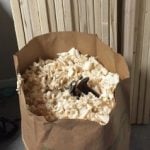Stanley #50 questions
Welcome! / Forums / General Woodworking Discussions / Tools and Tool Maintenance/Restoration / Stanley #50 questions
Tagged: combination plane, stanley #50
- This topic has 6 replies, 4 voices, and was last updated 7 years, 6 months ago by
YrHenSaer.
-
AuthorPosts
-
21 January 2017 at 6:14 pm #308560
I recently bought a very nice old Stanley #50 – came with all the cutters and looks 100% complete. Problem is I cant figure out how to use it 🙂
The 1/4″ cutter I tried is loose and I cant see how to fix that. There doesn’t appear to be any way to tighten it up.
Beyond that, I’m just not sure how to set it up. There are apparently 2 depth gauges? And at least a couple screws that I cant discern their function at all! Pretty sad, I know.
Has anyone found a tutorial on these tools?
Thanks all –
Joe

I too picked up a #50 lately. Depending on how old your model is, there were a lot of design tweaks through its history. I believe I have one of the first ones (all metal handle with some design work)–the way it is designed, I do not believe it can hold any cutters under 3/8″–the mechanism just doesn’t clamp down that tightly/can’t close that gap.
I also picked up a newer one with a wooden handle and it has the 2nd depth gauge included. Frankly, I don’t know what the 2nd one does–I think it may have some additional functionality for rabbets perhaps?
In any event, after sharpening the hell out of the cutters and bringing them back to good condition I found the plane works quite well. Make sure you hold it in a way that you can keep the fence firmly positioned against your reference face and make sure to start planing at the front of the wood and work your way back.
There is some interesting historical information here (someone shared this link on a post I made about the #50). http://www.supertool.com/StanleyBG/stan7.htm
My original thread: https://woodworkingmasterclasses.com/discussions/topic/stanley-50-combination-plane/

I recently picked up the #50 Type 8. It was brand new and in the original box and had never been used. It had all the cutters and all the other parts.
I wouldn’t mind hearing the answer to the questions above!
Regards,
Tim Turney-
This reply was modified 7 years, 6 months ago by
 tmpt.
tmpt.

I believe I answered it (or provided an information source on it). So I can’t speak to the 1/4″ issue–the article I posted said only the 1/8″ and 3/16″ cutters couldn’t be secured in the early model. Maybe you just need to sharpen it a bit more and really tighten the wing nut and see how it works? Obviously the sharper the cutter the less resistance you’ll get from the wood and the less likely you are to have an issue with the cutter moving.
From the article I posted (that was generously shared with me): There is one slight problem with this design of sandwiching the cutter between two castings to hold the cutter in place, and that is that the narrowest two ploughing cutters (1/8″ and 3/16″) aren’t wide enough to be secured in this manner. A holding screw was added when these two cutters were provided starting ca. 1936. The holding screw has a head that measures 3/4″ in diameter, and it’s this wide head that holds the cutter in place; the sliding section is removed, and the holding screw is substituted. The same wing nut that pulls the sliding section up against the left edge of the cutter also pulls the holding screw’s head against the left edge of the cutter. The holding screw is normally MIA.
21 January 2017 at 8:26 pm #308569OK, re-reading the info on Superior Works I think I’m beginning to see the answer. I need to remove the sliding section and use the “holding screw” when the small cutters are being used. I’ll try it.
Appreciate the info –
Joe
-
This reply was modified 7 years, 6 months ago by
joemonahan.

Reprints of users’ manuals for most types of combi planes, including some of the Stanley 50s made on both sides of the Atlantic are avaiable here:
http://www.cornishworkshop.co.uk/combinationplanes.html
Good luck
-
This reply was modified 7 years, 6 months ago by
-
AuthorPosts
- You must be logged in to reply to this topic.
